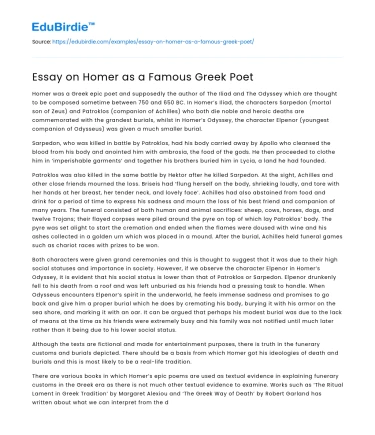Homer was a Greek epic poet and supposedly the author of The Iliad and The Odyssey which are thought to be composed sometime between 750 and 650 BC. In Homer’s Iliad, the characters Sarpedon (mortal son of Zeus) and Patroklos (companion of Achilles) who both die noble and heroic deaths are commemorated with the grandest burials, whilst in Homer’s Odyssey, the character Elpenor (youngest companion of Odysseus) was given a much smaller burial.
Sarpedon, who was killed in battle by Patroklos, had his body carried away by Apollo who cleansed the blood from his body and anointed him with ambrosia, the food of the gods. He then proceeded to clothe him in ‘imperishable garments’ and together his brothers buried him in Lycia, a land he had founded.
Save your time!
We can take care of your essay
- Proper editing and formatting
- Free revision, title page, and bibliography
- Flexible prices and money-back guarantee
Patroklos was also killed in the same battle by Hektor after he killed Sarpedon. At the sight, Achilles and other close friends mourned the loss. Briseis had ‘flung herself on the body, shrieking loudly, and tore with her hands at her breast, her tender neck, and lovely face’. Achilles had also abstained from food and drink for a period of time to express his sadness and mourn the loss of his best friend and companion of many years. The funeral consisted of both human and animal sacrifices: sheep, cows, horses, dogs, and twelve Trojans; their flayed corpses were piled around the pyre on top of which lay Patroklos’ body. The pyre was set alight to start the cremation and ended when the flames were doused with wine and his ashes collected in a golden urn which was placed in a mound. After the burial, Achilles held funeral games such as chariot races with prizes to be won.
Both characters were given grand ceremonies and this is thought to suggest that it was due to their high social statuses and importance in society. However, if we observe the character Elpenor in Homer’s Odyssey, it is evident that his social status is lower than that of Patroklos or Sarpedon. Elpenor drunkenly fell to his death from a roof and was left unburied as his friends had a pressing task to handle. When Odysseus encounters Elpenor’s spirit in the underworld, he feels immense sadness and promises to go back and give him a proper burial which he does by cremating his body, burying it with his armor on the sea shore, and marking it with an oar. It can be argued that perhaps his modest burial was due to the lack of means at the time as his friends were extremely busy and his family was not notified until much later rather than it being due to his lower social status.
Although the texts are fictional and made for entertainment purposes, there is truth in the funerary customs and burials depicted. There should be a basis from which Homer got his ideologies of death and burials and this is most likely to be a real-life tradition.
There are various books in which Homer’s epic poems are used as textual evidence in explaining funerary customs in the Greek era as there is not much other textual evidence to examine. Works such as ‘The Ritual Lament in Greek Tradition’ by Margaret Alexiou and ‘The Greek Way of Death’ by Robert Garland has written about what we can interpret from the deaths of Homeric characters and how it can be applied to our inferences about ancient Greek society.






 Stuck on your essay?
Stuck on your essay?

